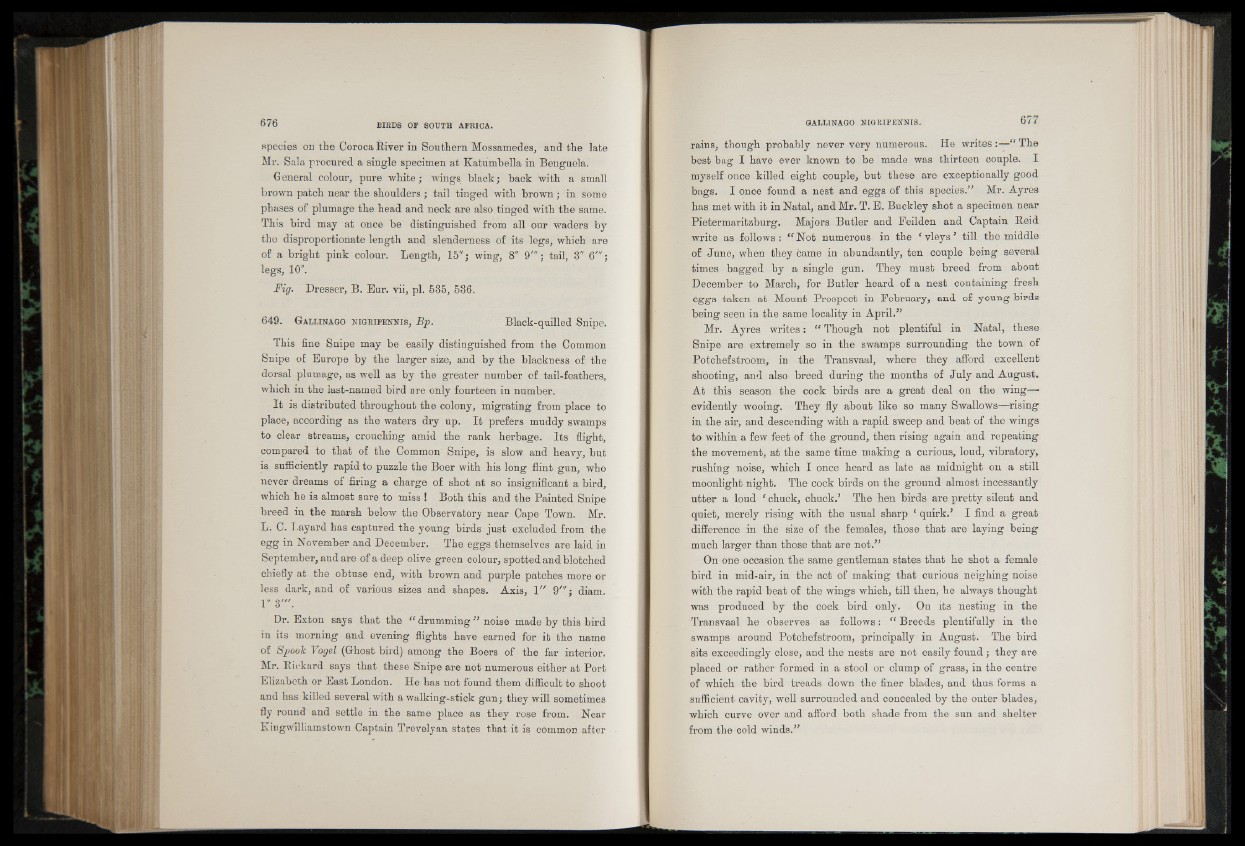
species on the Coroca River in Southern Mossamedes, and the late
Mr. Sala procured a single specimen at Katumbella in Benguela.
General colour, pure white; wings black; back with a small
brown patch near the shoulders; tail tinged with brown; in some
phases of plumage the head and neck are also tinged with the same.
This bird may at once be distinguished from all our waders by
the disproportionate length and slenderness of its legs, which are
of a bright pink colour. Length, 15"; wing, 8" 9"'; tail, 3" 6"';
legs, 10".
Fig. Dresser, B. Eur. vii, pi. 535, 536.
649. G allinago n ig r ip e n n is , Bp. Black-quilled Snipe.
This fine Snipe may be easily distinguished from the Common
Snipe of Europe by the larger size, and by the blackness of the
dorsal plumage, as well as by the greater number of tail-feathers,
which in the last-named bird are only fourteen in number.
I t is distributed throughout the colony, migrating from place to
place, according as the waters dry up. I t prefers muddy swamps
to clear streams, crouching amid the rank herbage. Its flight,
compared to that of the Common Snipe, is slow and heavy, but
is sufficiently rapid to puzzle the Boer with his long flint gun, who
never dreams of firing a charge of shot at so insignificant a bird,
which he is almost sure to miss ! Both this and the Painted Snipe
breed in the marsh below the Observatory near Cape Town. Mr.
L. C. Layard has captured the young birds just excluded from the
eSS in November and December. The eggs themselves are laid in
September, and are of a deep olive green colour, spotted and blotched
chiefly at the obtuse end, with brown and purple patches more or
less dark, and of various sizes and shapes. Axis, 1" 9'"; diam.
1" 3'".
Dr. Exton says that the “ drumming ” noise made by this bird
in its morning and evening flights have earned for it the name
of Spook Vogel (Ghost bird) among the Boers of the far interior.
Mr. Rickard says that these Snipe are not numerous either at Port
Elizabeth or East London. He has not found them difficult to shoot
and has killed several with a walking-stick gun; they will sometimes
fly round and settle in the same place as they rose from. Near
Kingwilliamstown Captain Trevelyan states that it is common, after
rains, though probably never very numerous. He writes :—“ The
best bag I have ever known to be made was thirteen couple. I
myself once killed eight couple, but these are exceptionally good
bags. I once found a nest and eggs of this species/’ Mr. Ayres
has met with it in Natal, and Mr. T. E. Buckley shot a specimen near
Pietermaritzburg. Majors Butler and Peilden and Captain Reid
write as follows: “ Not numerous in the ‘ vleys ’ till the middle
of June, when they came in abundantly, ten couple being several
times bagged by a single gun. They must breed from about
December to March, for Butler heard of a nest containing fresh
eggs taken at Mount Prospect in February, and of young birds
being seen in the same locality in April.”
Mr. Ayres writes: “ Though not plentiful in Natal, these
Snipe are extremely so in the swamps surrounding the town of
Potchefstroom, in the Transvaal, where they afford excellent
shooting, and also breed during the months of July and August.
At this season the cock birds are a great deal on the wing—
evidently wooing. They fly about like so many Swallows—rising
in the air, and descending with a rapid sweep and beat of the wings
to within a few feet of the ground, then rising again and repeating
the movement, at the same time making a curious, loud, vibratory,
rushing noise, which I once heard as late as midnight on a still
moonlight night. The cock birds on the ground almost incessantly
utter a loud ‘ chuck, chuck/ The hen birds are pretty silent and
quiet, merely rising with the usual sharp ‘ quirk/ I find a great
difference in the size of the females, those that are laying being
much larger than those that are not.”
On one occasion the same gentleman states that he shot a female
bird in mid-air, in the act of making that curious neighing noise
with the rapid beat of the wings which, till then, he always thought
was produced by the cock bird only. On its nesting in the
Transvaal he observes as follows: “ Breeds plentifully in the
swamps around Potchefstroom, principally in August. The bird
sits exceedingly close, and the nests are not easily found; they are
placed or rather formed in a stool or clump of grass, in the centre
of which the bird treads down the finer blades, and thus forms a
sufficient cavity, well surrounded and concealed by the outer blades,
which curve over and afford both shade from the sun and shelter
from the cold winds.”